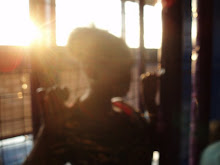Thesis:
In Rita Doves, Adolescence II, she uses imagery and dismantled structure to depict a story of ambiguity uncomfortable tone.
Body
1. imagery
- unpleasant references
~night and darkness
* no color can't see what's goin on. " @ the edge of darkness"- uncomfortable
2.auditory imagery
-"Can you feel it yet?" they whisper.
~whisperring: secrets, (ambiguity)
3.structure
-no set structure
-enjambment
-confusion: uncomfortable
Thursday, April 30, 2009
IB Questions
May 2008(a)
- Discuss the ways which at least two novels or story stories you have studied demonstrate that the search for identity can be a conscious or an unconscious process.
I plan to adress the aspect of charaterization in both the bluest eye and as i lay dying with the characters Pecola and Dewey dell. In the bluest i it was a conscious search for identity in beauty with the motif of blue eyes. And in AS i lay dying it was an unconcious process for dewey dell, becuase she was constantly searching for love.
May 2005
-Symbols and motifs are essential elements of many novelss and short stories. How have either or both of these devices been used and in your opinion, how successfully, in two or three of the works you have studied.
I would disscuss the pince nez motif in Darkness at noon because they are a tool reflects that realizations and realities of the party: examples would be in bogrovs liquidation, i would also discuss neomacheveillism. And the babydoll in the bluest eye because it helps develop the concept of beauty i n relation 2 tha master narrative.
- Discuss the ways which at least two novels or story stories you have studied demonstrate that the search for identity can be a conscious or an unconscious process.
I plan to adress the aspect of charaterization in both the bluest eye and as i lay dying with the characters Pecola and Dewey dell. In the bluest i it was a conscious search for identity in beauty with the motif of blue eyes. And in AS i lay dying it was an unconcious process for dewey dell, becuase she was constantly searching for love.
May 2005
-Symbols and motifs are essential elements of many novelss and short stories. How have either or both of these devices been used and in your opinion, how successfully, in two or three of the works you have studied.
I would disscuss the pince nez motif in Darkness at noon because they are a tool reflects that realizations and realities of the party: examples would be in bogrovs liquidation, i would also discuss neomacheveillism. And the babydoll in the bluest eye because it helps develop the concept of beauty i n relation 2 tha master narrative.
Passage V-outline "The Voice" by Thomas Hardy
Thesis:
In Thomas Hardy's "The Voice" he use imagery to provoke a longing tone, in order to show how powerful love is. Love is a metaphysical that most have not mastered and some haven't even experienced. Love has the ability to manipulate the emotion of desire or longing. And through Hardy's piece he conveys this tone of desiring and longing also.
Body:
Auditory imagery:
1st line: " Saying that now you are not as you were"
~a womens voice
~rejecting a man
~recalling what she say
`disturbed state; shows the power of love
~a change has occured; a disjoin in the relationship
2nd stanza: "Can it be you that I hear? Let me view you, then,Standing as when I drew near to the town"
~he no longer is recalling accounts of what she says
~he is asking her longing for her in the present time
`provokes this longing tone "let me"
`almost as if he is asking for her permission to look @ her
~the aspect of distance is addressed
`"I drew near to the town"
3rd stanza: "Or is it only the breeze in its listlessness Travelling across the wet mead to me here,"
~Visual imagery
~"breeze"- cool calmness
"Listlessness"- not forced but easy and not structure
-Similar to love which has no form or structure
~ "Travelling"- connotes movement and changes
- love has the ability to take u were it wants you to go....
In Thomas Hardy's "The Voice" he use imagery to provoke a longing tone, in order to show how powerful love is. Love is a metaphysical that most have not mastered and some haven't even experienced. Love has the ability to manipulate the emotion of desire or longing. And through Hardy's piece he conveys this tone of desiring and longing also.
Body:
Auditory imagery:
1st line: " Saying that now you are not as you were"
~a womens voice
~rejecting a man
~recalling what she say
`disturbed state; shows the power of love
~a change has occured; a disjoin in the relationship
2nd stanza: "Can it be you that I hear? Let me view you, then,Standing as when I drew near to the town"
~he no longer is recalling accounts of what she says
~he is asking her longing for her in the present time
`provokes this longing tone "let me"
`almost as if he is asking for her permission to look @ her
~the aspect of distance is addressed
`"I drew near to the town"
3rd stanza: "Or is it only the breeze in its listlessness Travelling across the wet mead to me here,"
~Visual imagery
~"breeze"- cool calmness
"Listlessness"- not forced but easy and not structure
-Similar to love which has no form or structure
~ "Travelling"- connotes movement and changes
- love has the ability to take u were it wants you to go....
Subscribe to:
Comments (Atom)
